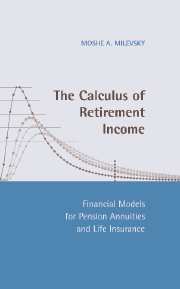Book contents
- Frontmatter
- Contents
- List of Figures and Tables
- I MODELS OF ACTUARIAL FINANCE
- 1 Introduction and Motivation
- 2 Modeling the Human Life Cycle
- 3 Models of Human Mortality
- 4 Valuation Models of Deterministic Interest
- 5 Models of Risky Financial Investments
- 6 Models of Pension Life Annuities
- 7 Models of Life Insurance
- 8 Models of DB vs. DC Pensions
- II WEALTH MANAGEMENT: APPLICATIONS AND IMPLICATIONS
- III ADVANCED TOPICS
- Bibliography
- Index
2 - Modeling the Human Life Cycle
from I - MODELS OF ACTUARIAL FINANCE
Published online by Cambridge University Press: 06 July 2010
- Frontmatter
- Contents
- List of Figures and Tables
- I MODELS OF ACTUARIAL FINANCE
- 1 Introduction and Motivation
- 2 Modeling the Human Life Cycle
- 3 Models of Human Mortality
- 4 Valuation Models of Deterministic Interest
- 5 Models of Risky Financial Investments
- 6 Models of Pension Life Annuities
- 7 Models of Life Insurance
- 8 Models of DB vs. DC Pensions
- II WEALTH MANAGEMENT: APPLICATIONS AND IMPLICATIONS
- III ADVANCED TOPICS
- Bibliography
- Index
Summary
The Next Sixty Years of Your Life
Suspend your disbelief for a moment and bear with me as I imagine the next sixty years of your financial life. Assume that you enter the labor force or start working at the age of 35. Your job is expected to pay a fixed and predictable $50,000 per year for the next thirty years, after which you retire at age 65. This job provides no pension or retirement benefits. Rather, it is your personal responsibility to make sure you save enough during your thirty working years so that you can maintain a dignified standard of living or consumption during your retirement years. For the moment, let us ignore inflation and income taxes—two important issues I shall address in detail later—and finally, imagine you die at the ripe old age of 95.
What fraction of your salary must you save during your thirty years of work so that, when you retire with your accumulated nest egg, you can generate an equivalent income stream that will last for the remaining thirty years of life?
Note that if your saving rate is too high—say $20,000 per year, leaving you with only $50,000 – $20,000 = $30,000 annually to live off during your working years—then you might end up with a much better lifestyle when you are retired as compared to when you are working. That wouldn't make sense, would it?
- Type
- Chapter
- Information
- The Calculus of Retirement IncomeFinancial Models for Pension Annuities and Life Insurance, pp. 17 - 33Publisher: Cambridge University PressPrint publication year: 2006



